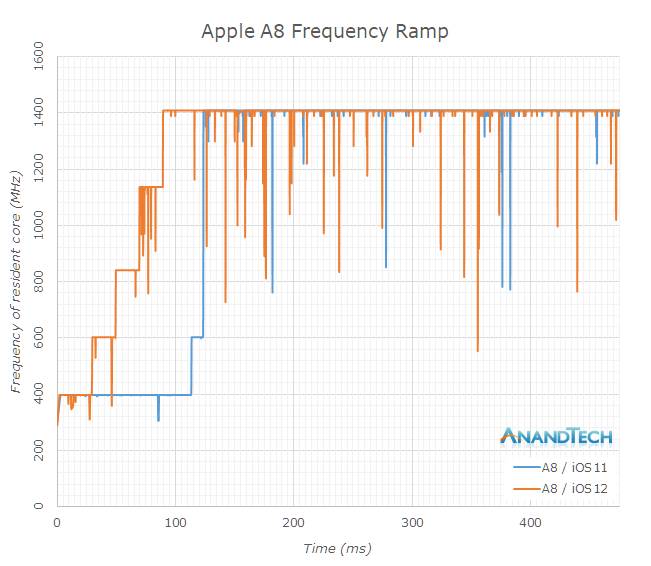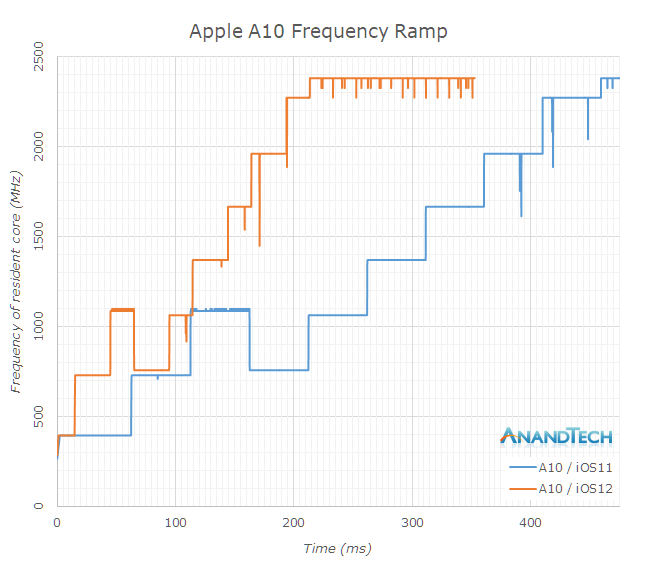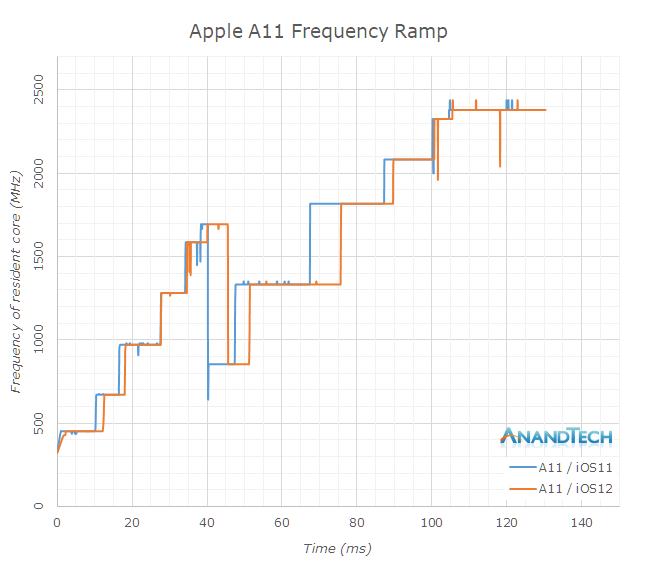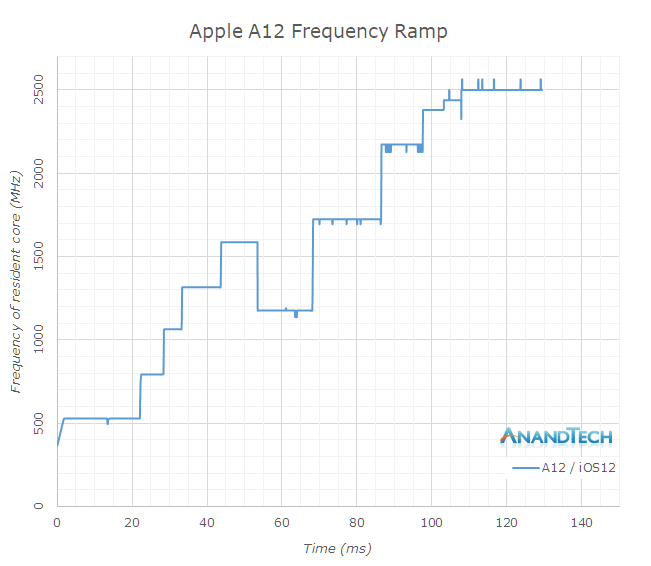The iPhone XS & XS Max Review: Unveiling the Silicon Secrets
by Andrei Frumusanu on October 5, 2018 8:00 AM EST- Posted in
- Mobile
- Apple
- Smartphones
- iPhone XS
- iPhone XS Max
System Performance
While synthetic test performance is one thing, and hopefully we’ve covered that well with SPEC, interactive performance in real use-cases behaves differently, and here software can play a major role in terms of the perceived performance.
I will openly admit that our iOS system performance suite looks extremely meager: we are only really left with our web browser tests, as iOS is quite lacking in meaningful alternatives such as to PCMark on the Android side.

Speedometer 2.0 is the most up-to-date industry standard JavaScript benchmark which tests the most common and modern JS framework performance.
The A12 sports a massive jump of 31% over the A11, again pointing out that Apple’s advertised performance figures are quite underselling the new chipset.
We’re also seeing a small boost from iOS 12 on the previous generation devices. Here the boost comes not only thanks to an a change in how iOS’s scheduler handles load, but also thanks to further improvements in the ever evolving JS engine that Apple uses.

WebXPRT 3 is also a browser test, however its workloads are more wide-spread and varied, containing also a lot of processing tests. Here the iPhone XS showcases a smaller 11% advantage over the iPhone X.
Former devices here also see a healthy boost in performance, with the iPhone X ticking up from 134 to 147 points, or 10%. The iPhone 7’s A10 sees a larger boost of 33%, something we’ll get into more detail in a little bit.
iOS12 Scheduler Load Ramp Analyzed
Apple promised a significant performance improvement in iOS12, thanks to the way their new scheduler is accounting for the loads from individual tasks. The operating system’s kernel scheduler tracks execution time of threads, and aggregates this into an utilisation metric which is then used by for example the DVFS mechanism. The algorithm which decides on how this load is accounted over time is generally simple a software decision – and it can be tweaked and engineered to whatever a vendor sees fit.
Because iOS’s kernel is closed source, we’re can’t really see what the changes are, however we can measure their effects. A relatively simple way to do this is to track frequency over time in a workload from idle, to full performance. I did this on a set of iPhones ranging from the 6 to the X (and XS), before and after the iOS12 system update.
Starting off with the iPhone 6 with the A8 chipset, I had some odd results on iOS11 as the scaling behaviour from idle to full performance was quite unusual. I repeated this a few times yet it still came up with the same results. The A8’s CPU’s idled at 400MHz, and remained here for 110ms until it jumped to 600MHz and then again 10ms later went on to the full 1400MHz of the cores.
iOS12 showcased a more step-wise behaviour, scaling up earlier and also reaching full performance after 90ms.
The iPhone 6S had a significantly different scaling behaviour on iOS11, and the A9 chip’s DVFS was insanely slow. Here it took a total of 435ms for the CPU to reach its maximum frequency. With the iOS12 update, this time has been massively slashed down to 80ms, giving a great boost to performance in shorter interactive workloads.
I was quite astonished to see just how slow the scheduler was before – this is currently the very same issue that is handicapping Samsung’s Exynos chipsets and maybe other Android SoCs who don’t optimise their schedulers. While the hardware performance might be there, it just doesn’t manifest itself in short interactive workloads because the scheduler load tracking algorithm is just too slow.
The A10 had similar bad characteristics as the A9, with time to full performance well exceeding 400ms. In iOS12, the iPhone 7 slashes this roughly in half, to around 210ms. It’s odd to see the A10 being more conservative in this regard compared to the A9 – but this might have something to do with the little cores.
In this graph, it’s also notable to see the frequency of the small cores Zephyr cores – they start at 400MHz and peak at 1100MHz. The frequency in the graph goes down back to 758MHz because at this point there was a core switch over to the big cores, which continue their frequency ramp up until maximum performance.
On the Apple A11 – I didn’t see any major changes, and indeed any differences could just be random noise between measuring on the different firmwares. Both in iOS11 and iOS12, the A11 scales to full frequency in about 105ms. Please note the x-axis in this graph is a lot shorter than previous graphs.
Finally on the iPhone XS’s A12 chipset, we can’t measure any pre- and post- update as the phone comes with iOS12 out of the box. Here again we see that it reaches full performance after 108ms, and we see the transition of the tread from the Tempest cores over to the Vortex cores.
Overall, I hope this is the best and clear visual representation of the performance differences that iOS12 brings to older devices.
In terms of the iPhone XS – I haven’t had any issues at all with performance of the phone and it was fast. I have to admit I’m still a daily Android user, and I use my phones with animations completely turned off as I find they get in the way of the speed of a device. There’s no way to completely turn animation off in iOS, and while this is just my subjective personal opinion, I found they are quite hampering the true performance of the phone. In workloads that are not interactive, the iPhone XS just blazed through them without any issue or concern.















253 Comments
View All Comments
patel21 - Saturday, October 6, 2018 - link
Exactly. In India we have a new Carrier service called Jio doing exactly the same. They built their network group up on VoIP and only sell data. Calls and SMS are totally free.And man can you imagine I am using their plan of 2GB data per DAY for 90 days at just USD 8 !!!
phoenix_rizzen - Friday, October 5, 2018 - link
You mean Qualcomm, not 3Com. :)bull2760 - Sunday, October 7, 2018 - link
Yes thank you sorry meant Qualcomm, my bad.varase - Friday, October 5, 2018 - link
I just downloaded 12.1 Developer Beta 2 and in my 2 bar AT&T household, I went up from about 11 mbps to 38 mbps.My local cell tower probably doesn't have 4x4 mimo, though my Orbis are pushing 298 mpbs through wifi and saturating my internet link.
It's a little early to jump ship - there's bound to be a few rough edges that'll have to get filed down :-).
Speedfriend - Monday, October 8, 2018 - link
What, your mobile data speed has been only 11mbps, where do you live? How on earth do you use your phone like that! I regularly get over 100mbps where I live in London, with the highest I have recorded being 134mbpsbull2760 - Sunday, October 14, 2018 - link
Little early to jump ship. Do you remember antennagate? Steve Jobs answer to a design issue, “you are holding the phone wrong”. Sorry not forming out 1500 for a phone that has cellular as well as network related issues. How this ever passed inspection in testing is beyond me. I’m an Apple fan, have owned every iPhone since they started making them. This is without a doubt the worst performing iPhone I ever purchased. Yes it was snappy and apps flew open. But if I can’t use the phone aspect or wireless networking at home, I may as well hold a paperweight to my ear. I’m heavily entrenched into the Apple ecosystem. Watches, TV, iPads and MacBook Pro. Not to mention all the movies, music and apps that I’ve purchased. This pisses me off. 1500 for a piece a shit phone that was not properly tested before being released.Marlin1975 - Friday, October 5, 2018 - link
The thing that jumps out to me is the power usage and performance gains at the same time. TSMC's 7nm process looks really good. I wonder if this will also play out on CPUs/GPUs on the same process coming soon.melgross - Saturday, October 6, 2018 - link
It’s hard to say how much of what Apple gets out of these processes others will get. Apple has bought a lot of equipment for TSMC, as they’ve done for other companies, including Samsung, over the years. What they get out of it is early access to new processes, as well as some more specialized features that they have often developed themselves, as well as extra discounts.KPOM - Friday, October 5, 2018 - link
Intel should be worried.varase - Friday, October 5, 2018 - link
I still think the star of the show may end up being the neural processor, up from 660 billion ops/sec to 5 trillion (9x the speed at a tenth the energy usage) - now available to developers via Core ML 2, and now pipelined through the ISP.